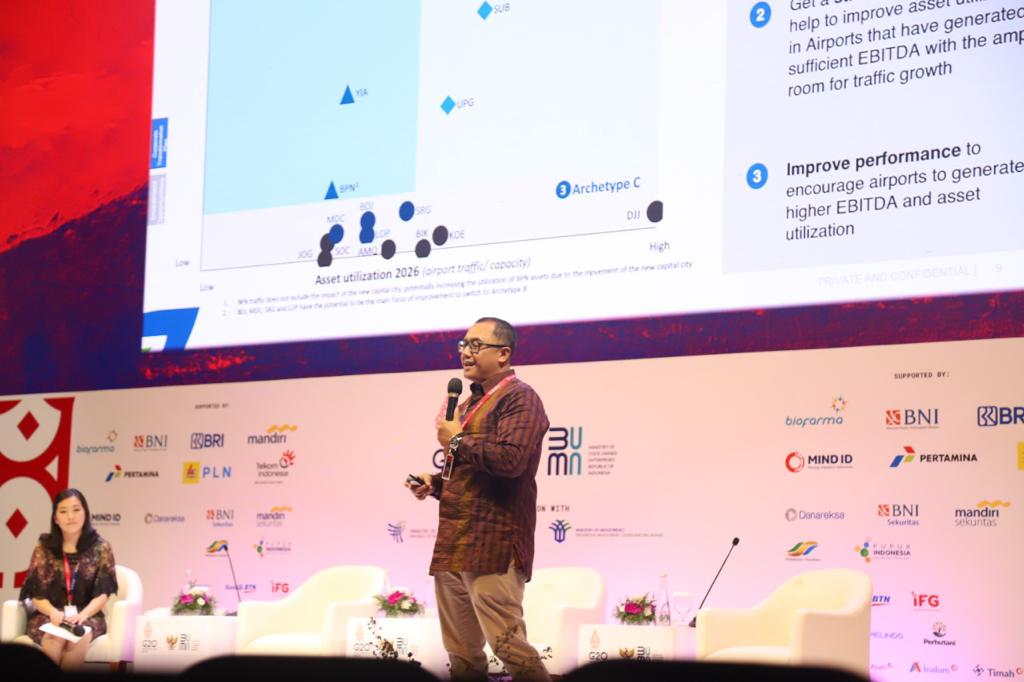JAKARTA – PT Angkasa Pura I, which operates 15 airports in Indonesia, offers cooperation opportunities to a number of potential investors in the SOE International Conference agenda which will be held on Tuesday (18/10) at the Bali Nusa Dua Convention Center, Bali. The agenda is one of the side events ahead of the G20 Bali Summit on November 15-16.
In the discussion panel, Angkasa Pura I was represented by President Director Faik Fahmi and Director of Business Development Dendi T. Danianto, and was attended by a number of potential national and international investors from various industrial sectors.
“On this occasion, we convey a number of achievements that have been achieved by the Company so far, how Angkasa Pura I can survive during the global Covid-19 pandemic, and offer a number of cooperation opportunities to potential investors,” said PT Angkasa Pura I President Director Faik Fahmi. .
“Angkasa Pura I currently manages 15 airports with the characteristics of each airport tailored to the potential possessed by each region. For example, I Gusti Ngurah Rai Airport, Lombok International Airport, and Yogyakarta International Airport are the gateways to leading tourism areas. Meanwhile “Sultan Hasanuddin Airport Makassar and Sentani Jayapura Airport are hub airports and have a very large potential for cargo traffic in the Eastern Indonesia region. This is a selling point that we think is quite attractive in the eyes of potential investors,” continued Faik Fahmi.
In the agenda, Angkasa Pura I explained about the division of airport clusters that are managed into four clusters. The first cluster is an airport grouped as International Tourism and Super Hub which includes Bali’s I Gusti Ngurah Rai Airport, Lombok International Airport, and Kupang El Tari Airport, where the three airports are projected to be the main gateways for Indonesian tourism for international tourism players.
The second cluster is the International Transit and Industrial Hub cluster, which consists of two sub-clusters, namely the International Transit and Industrial Hub sub-clusters. Yogyakarta Kulon Progo International Airport, Yogyakarta Adisutjipto Airport, Adi Soemarmo Airport Surakarta, and General Ahmad Yani Airport Semarang are included in the International Transit Hub sub-cluster, while the Industrial Hub sub-cluster is filled by Juanda Airport Surabaya.
The third cluster is the New Capital Gateway which consists of airports projected to support the air traffic of the New Capital City, namely SAMS Sepinggan Airport Balikpapan and Syamsudin Noor Airport Banjarmasin.
While the fourth cluster is the Eastern Gateway and East Asia Export Gateway cluster consisting of two sub-clusters, namely Eastern Gateway which contains Sultan Hasanuddin Airport Makassar, Frans Kaisiepo Airport Biak, and Pattimura Airport Ambon, as well as the East Asia Export Gateway sub-cluster consisting of Sam Ratulangi Airport. Manado and Jayapura Sentani Airport.
“We offer several ‘benefits’ for potential investors. Angkasa Pura I is one of the largest airport management companies in Indonesia, even in the region, with a total passenger capacity at the airports we manage up to 143 million passengers per year. The airports we manage also quite diverse, with the function of the airport as a gateway for tourism, industry, and business areas,” said Director of Business Development of PT Angkasa Pura I Dendi T. Danianto.
Dendi added that the potential investors who attended had diverse enthusiasm and interest in the offered clusters, this was in line with the credibility of Angkasa Pura I in conducting strategic collaborations with international partners. “The success of Angkasa Pura I with Incheon International Airport Corporation in the Hang Nadim Batam PPP Project is a portfolio that can foster the confidence of potential investors to conduct strategic cooperation in the clusters that we offer,” he added.
Potential investors who attended the business presentation session included Tony Blair Foundation, ING Bank, Astra Infra, JPMorgan, Skyview Construction, ITOCHU Corporation, Whitesky Facility, GMR Group, and Malaysia airports.
“Meanwhile, in terms of the company’s financial performance, in the 2015-2019 period, Angkasa Pura I managed to book an average company revenue growth of up to 13% and an average EBITDA margin of up to 38%. We managed to survive during the pandemic, and we are currently “We are on a positive path in recovering the company’s financial performance post-pandemic. With these advantages, strategic cooperation with potential investors and business partners will further improve the company’s operational and financial performance in the future,” concluded Dendi. * * *go


